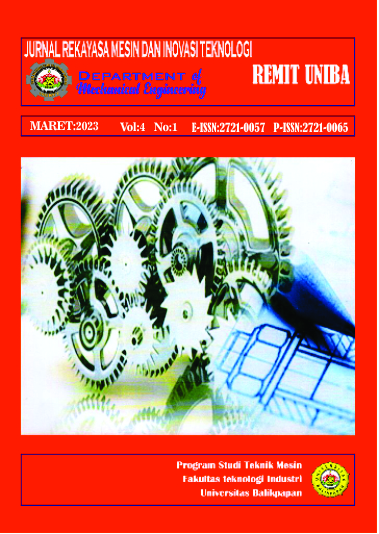Performance Test of Solar Charging System for Inovasi Karya Nusa (IKN) Electric Cars
Electric Cars
Keywords:
Solar panels, electric vehicle, power, efficiencyAbstract
Currently, the latest innovations in the automotive sector are focused on electric vehicles, especially electric cars. Electric cars are vehicles that use electrical energy as their main source to power electric motors. In the use of electric cars, they require electric energy for charging the electric car batteries, which can be obtained from alternative electrical sources such as solar panel charging systems. The independent variables in this study were solar radiation and testing duration from 10:00 to 14:00. The dependent variables in this research were power (Watt), solar panel efficiency, and the electric vehicle's additional mileage from solar power charging system energy. The controlled variables in this research were voltage, current, and battery capacity. The average energy output generated by the solar panel over the course of seven days is 550.47 Wh. The highest energy output from the solar panel during the testing was 658.34 Wh, which occurred on the second day. The average solar irradiance received by the solar panel was 977.6 W/m2, and the average efficiency value was 43.89%. This resulted in the highest efficiency value during the seven-day testing period. Based on the calculations from this testing, the average additional distance covered by the electric car was 4.65 Km, with the farthest additional distance of 5.56 Km achieved on the second day of testing. Therefore, by implementing the solar charging system in this electric car, the driving range can be extended from the original 69.36 Km to 74.01 Km.
References
R. Mulyadi, K. D. Artika, and M. Khalil, “Perancangan Sistem Kelistrikan Perangkat Elektronik Pada Mobil Listrik,” Elem. J. Tek. Mesin, vol. 6, no. 1, p. 07, 2019, doi: 10.34128/je.v6i1.85.
Y. Prasetyo, B. Triyono, and A. C. Arifin, “Optimalisasi Daya Output Dual Axis Solar Tracker Dengan Metode Umbrella System,” J. Geuthee, vol. 2, no. 02, p. 8, 2019.
Y. Prasetyo, “Otomatisasi Sistem Pengisian Baterai Pada Sistem Tenaga Surya,” J. Geuthèë Penelit. Multidisiplin, vol. 4, no. 3, p. 153, 2021, doi: 10.52626/jg.v4i3.131.
T. Gofilin, “Penyusunan Standar Uji Performa Dan Keselamatan Peralatan Battery Swap Station,” 2019.
D. Ady Pratama and I. Herlamba Siregar, “Uji Kinerja Panel Surya Tipe Polycrystalline 100Wp,” Jptm, vol. 6, no. 3, pp. 79–85, 2018.
R. Syahyuniar, “Pengaplikasian Panel Surya Pada Mobil Listrik,” Elem. J. Tek. Mesin, vol. 3, no. 1, p. 10, 2016, doi: 10.34128/je.v3i1.10.
Y. Prasetyo, B. Triyono, H. Kusbandono, A. Tranggono, and A. Salim, “Optimization of Solar Panel Output Using Smart Relay,” vol. 5, no. 4, pp. 78–80, 2020.
P. Harahap, “Pengaruh Temperatur Permukaan Panel Surya Terhadap Daya Yang Dihasilkan Dari Berbagai Jenis Sel Surya,” pp. 73–80, 2020.
I. K. Wijaya, “Penggunaan Dan Pemilihan Pengaman Mini Circuit Breaker ( MCB ) Secara Tepat Menyebabkan Bangunan Lebih Aman Dari Kebakaran,” vol. 6, no. 2, 2007.


